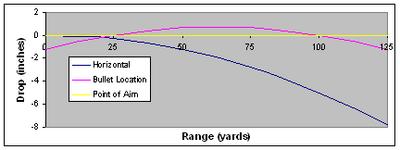First go to a good shooting center. Some place with a nice stable shooting bench and seats. These are important because you can sit down, put your arm on the bench, and shoot from a well-supported position that is much more innately accurate than shooting offhand. Ommelanden in Newcastle has these facilites, but my last range did not. It removes lot of bad technique (mine) from the equation and leaves only the gun's inherent accuracy behind.
The problem now is an academic one: What range should I zero the gun for? Well this depends on the gun and the job doesn't it? If I were smart I would zero my M1 at 25 meters.
How do I know that 25 meters is a good range? I did my research. You can start with some of the stock tables on ammunition manufacturers websites like Winchester or Remington. Just look up your ammo and they will give you trajectory for bullet rise and fall. Remington also offers some free software that is very useful.
Now some of you may be noticing that I said rise and fall for the bullet. Bullets only fall right? Gravity and such. Well that would be true if the barrel was fired horizontal to the ground, but most guns are sighted so that the barrel actually points upwards ever so slightly. Why? Well here is a picture:

Bullets travel in a parabolic arc (if you neglect wind resistance). So if the barrel is horizontal, where you point the gun is the yellow line and where the bullet strikes is the blue line. They only coincide at one point, the muzzle. After that it just gets worse and worse. You have a gun that is only useful at point blank range. No thank you, I want to be able to reach out and touch someone.
Now if you zero the gun so that the gun and sights are at a slight angle things become more useful. Now the bullet travels the pink path. The gun shoots exactly where you aim at two ranges and for most of its useful flight path it is less than an inch off the mark. An inch doesn't really matter much for most practical purposes.
So I zeroed my gun at 25m and it also happens to be zeroed at 100 yards too. If I wanted to zero it farther out, say 200 yards, I could. Then my bullets would be farther off the point of aim for some parts of the trajectory. That might be the price you have to bear if you are planning to shoot longer distances. I'm not planning to shoot long distances, I have crappy eyesight and the .30 carbine doesn't have the oomph for it anyway.

No comments:
Post a Comment